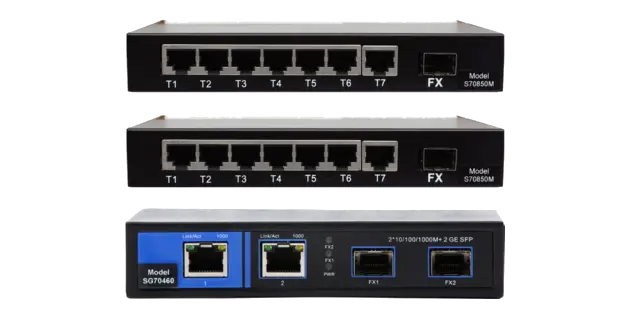Industrial Network Switches

Features of Industrial Network Switches
1. Ruggedized Enclosures
Industrial switches are built with metallic or reinforced plastic casings that protect against dust, moisture, and electromagnetic interference (EMI). Many models are IP-rated for resistance to water and debris.
2. Wide Operating Temperature Range
Unlike commercial switches, which typically operate between 0°C and 40°C, industrial switches function in extreme temperatures ranging from -40°C to 75°C, making them ideal for outdoor or factory environments.
3. Shock and Vibration Resistance
Industrial network switches comply with IEC 60068-2-6 and IEC 60068-2-27 standards for vibration and shock resistance, ensuring durability in applications such as transportation and heavy machinery operations.
4. Redundant Power Inputs
Many industrial switches feature dual power inputs, ensuring continued operation if the primary power source fails. This redundancy prevents downtime in critical industrial applications.
5. DIN-Rail or Rack Mounting
Industrial switches are available in DIN-rail or rack-mounted designs for flexible installation in control panels, cabinets, or server rooms.

Applications of Industrial Network Switches

Manufacturing and Automation
Industrial Ethernet switches are widely used in smart factories, connecting PLC (Programmable Logic Controllers), HMIs (Human-Machine Interfaces), and SCADA (Supervisory Control and Data Acquisition) systems. These switches provide low-latency communication, ensuring precise and real-time control of automated processes.

Transportation and Traffic Control
In intelligent transportation systems (ITS), industrial switches support traffic management, railway communication, and automated toll collection. These switches ensure stable network connectivity for traffic signals, surveillance cameras, and vehicle tracking systems.

Oil, Gas, and Energy Sector
Industrial network switches are deployed in offshore drilling rigs, power plants, and substations where rugged network infrastructure is required. These environments demand high-reliability switches that can withstand harsh outdoor conditions and electromagnetic interference.

Smart Cities and Surveillance Systems
Industrial switches are essential for city-wide surveillance networks, street lighting systems, and environmental monitoring. PoE-enabled switches power IP cameras and IoT sensors, reducing cabling complexity and installation costs.

Marine and Offshore Applications
Ships and offshore platforms require industrial switches that comply with marine standards such as DNV GL and IEC 60945 for network stability in saltwater environments.
Benefits of Industrial Network Switches
Reliability in Harsh Environments
Industrial switches operate under extreme conditions, providing long-term reliability and reducing maintenance costs.
Scalability and Flexibility
Managed industrial switches allow businesses to expand their networks while maintaining efficient traffic management and security.
Improved Security
Industrial switches support access control, encryption, and network segmentation to protect critical infrastructure from cyber threats.
Lower Downtime with Redundancy Features
Network redundancy protocols ensure that data transmission continues even in case of link or power failures, preventing costly downtime.
Selecting the Right Industrial Network Switch
- Determine Environmental Conditions
- Indoor or Outdoor Use? Choose IP-rated switches for outdoor deployment.
- Temperature and Humidity? Ensure the switch supports extreme conditions.
- Assess Network Size and Traffic
- Small-scale automation? Use unmanaged or basic managed switches.
- Complex industrial networks? Opt for Layer 3 managed switches for better control and routing.
- Check Power Requirements
- If devices require remote power, PoE-enabled industrial switches are recommended.
- Consider Network Redundancy
- Mission-critical applications require redundancy features such as STP, ERPS, and dual power inputs.
- Evaluate Security Features
Use managed switches with VLANs, ACLs, and 802.1X authentication for secure industrial networking.
